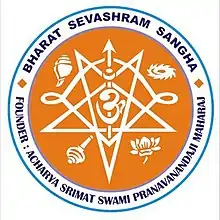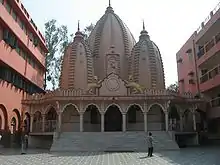Bharat Sevashram Sangha
Bharat Sevashram Sangha is a Hindu religious and spiritual organisation focused on humanitarian work. It was founded in 1917 by the illustrious patriot saint Acharya Srimat Swami Pranavananda Maharaj. It is purely a philanthropic and charitable organization with non-sectarian, non-communal and non-political character and outlook. The headquarter of the Sangha is situated in Kolkata, West Bengal with more than three hundreds of branches in India and also in other countries including the United Kingdom, United States, Guyana, Trinidad and Tobago, Canada, Fiji and Bangladesh.[1] It has initiated several missions to African countries, Malaysia, and Indonesia; monks from the Sangha have accompanied United Nations delegations to Syria and Lebanon.[2]
 Emblem of Bharat Sevashram Sangha | |
| Formation | 1917 |
|---|---|
| Founder | Swami Pranavananda |
| Type | Religious organisation |
| Purpose | Educational, Philanthropic, Religious Studies, Spirituality |
| Headquarters | Kolkata, West Bengal, India |
Region served | Worldwide |
| Website | www |
| Part of a series on |
| Hinduism |
|---|
 |
|
|
Activities
The Sangha is recognized for their community work, helping poor and providing healthcare to those in need.

The Sangha has responded to natural calamities in Andhra Pradesh and Orissa states, the Bengal famine of 1943, the Bhopal disaster, the 2001 Gujarat earthquake, and the 2004 Indian Ocean tsunami.[3] At times of political unrest such as the Partition of India, the Sangha has set up refugee camps and war evacuee camps in the border areas.[2][4]
It has organised several projects to help impoverished Indian tribal people. One such project involved providing schooling for children of the Sabar tribe and providing them with housing and healthcare.[5] It also hosts courses to train youths in information technology to enable them to find jobs which require IT skills.[6]
Following the 2004 Indian Ocean earthquake, the Sangha's monks proposed to set up a school for orphans at a cost of Rs. 4250,000s, an orphanage at Rs.6020,000, and 200 houses at Rs.30 million on the Andaman and Nicobar Islands.[7] In Tamil Nadu state, where the tsunami killed more than 7,000 in the districts of Cuddalore, Nagapattinam and Chennai, the Sangha was one of the first to begin massive relief operations by building nearly 200 new houses at Sonankuppam village in Cuddaloer. Fishing boats and nets were also distributed to locals who had lost everything to the sea.
The Sangha actively provides shelter, food, medical treatment and public safety services to pilgrims at various places of worship and religious fairs in India, such as the Kumbha Mela.[8] It operates free hospitals at Barajuri and Kolkata, mobile dispensary and medical units in sixty-four locations, a free residence for patients and their families in Navi Mumbai, and four hospitals and homes for leprosy patients.[9] A 500-bed hospital at Joka, Kolkata was inaugurated in 2010 by the Indian Finance Minister as an example of private-public partnerships in healthcare.[9]
In May 2020, the Sangha was one of the few organizations who extended help to the people after the destruction caused by Cyclone Amphan.[10] They also provided relief work to almost thousands people per day with food at different parts of the country due to COVID-19 lockdown in India.[11]
References
- "List of Centres | Bharat Sevashram Sangha". www.bharatsevashramsangha.org. 1 December 2019.
- "Bharat Sevashram Sangha gets into film production to spread message against violence". Hindustan Times. 6 September 2016. Retrieved 9 October 2021.
- "Address on, Secularism and National Integration, at the Annual Celebration Day of the Bharat Sevashram Sangha, New Delhi, 24 October 2008". The Office of Speaker Lok Sabha. 24 October 2008. Retrieved 25 November 2008.
Bharat Sevashram Sangha, with the goal of universal emancipation, has been tirelessly working for the uplift of the downtrodden and the neglected sections of our society, ever since its foundation in 1917. Its efforts in reaching out to the people in distress, particularly during natural calamities are most commendable. The extensive relief and rehabilitation works undertaken by the Sangha during the Bengal famine, Midnapore cyclone, West Bengal Floods, Bhopal Gas Tragedy, Andhra Pradesh Cyclone, Orissa Super Cyclone, the devastating tsunami and the recent floods in Bihar, to name some of the occasions...
- Das, Suhasini (2004). Noakhali:1946. Dhaka: Sahitya Prakash. p. 13. ISBN 984-465-373-8.
- Sanjay Ojha (18 May 2005). "The winds of change – Tribes at crossroads". The Telegraph. Calcutta. Retrieved 15 November 2008.
- Jayesh Thaker (19 March 2005). "Dreams crash for tech band – Tribal youths face uncertain future after completion of computer course". The Telegraph. Calcutta. Archived from the original on 9 December 2010. Retrieved 15 November 2008.
- "Monks to take up rehabilitation in Andaman and Nicobar". The Hindu. 19 February 2005. Archived from the original on 3 November 2012. Retrieved 15 November 2008.
- Saha, Dibyendu (9 January 2019). "গঙ্গাসাগর ও কুম্ভ মেলায় উদ্ধারকাজ! সাঁতারু দিয়ে সাহায্য ভারত সেবাশ্রম সংঘের". Oneindia (in Bengali). Archived from the original on 2 February 2019. Retrieved 9 October 2021.
- Staff Reporter (5 April 2010). "Hospital for poor opens doors". The Telegraph. Calcutta. Retrieved 16 November 2010.
- "West Bengal: Thousands of People Get Help from Organisations After Cyclone Amphan Devastates State". News18. 24 May 2020.
- "Coronavirus in Delhi: Today's news from your locked-down city | Delhi News - Times of India". The Times of India. 31 March 2020.
